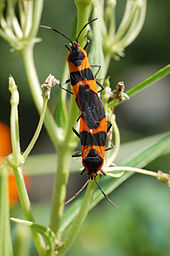- Large milkweed bug
-
Large milkweed bug 
Scientific classification Kingdom: Animalia Phylum: Arthropoda Class: Insecta Order: Hemiptera Family: Lygaeidae Genus: Oncopeltus Species: O. fasciatus Binomial name Oncopeltus fasciatus
(Dallas, 1852) [1]The milkweed bug, Oncopeltus fasciatus, is a medium–sized hemipteran (true bug) of the family Lygaeidae. It feeds mainly on grains, particularly those of the milkweed. Like all hemiptera, it feeds through a long mouthpart known as a rostrum. O. fasciatus is commonly used in science due to ease of rearing and ease of dissection.
Contents
Identification and appearance
The large milkweed bug adult is a 9–18 mm long insect. Mature adults are orange with black rhomboidal spots at both end of a body and a black band in the middle. Freshly molted individuals are pale yellow with gray spots that change into black with time. Bright orange instars resemble adults, with orange-black pattern different than in grown individual and without wings. However, wingpads are visible and become more pronounced with each molt. Adult females have several black spots on rear part of their abdomen, while males have only one.
Habitat
The habitat of the large milkweed bug spreads east of the Rocky Mountains. It is found as far north as Ontario, Canada, but is more abundant in south-eastern United States. Groups of insects in all stages of development are commonly found between May and October on common milkweed plants.
Life cycle and biology
Adults that survived winter mate in May-June, when common milkweed plants have grown enough to provide shelter. During mating, female and male may become connected for up to 10 hours. Eggs are laid on seed pods or under a leaf. Average female lays 30 pale orange eggs in a day, in several batches during summer. Eggs change color, becoming more intensely orange toward hatching. This insect undergoes incomplete metamorphosis. Nymphs hatch after about 1 week and molt 5 times before becoming adults.
Adults and nymphs feed on milkweed plant juices, seeds and occasionally on other plant juices. When their native plant is scarce, they may become scavengers and predators. Both nymphs and adults use milkweed as their primary source of food.
After feeding on milkweed plant or seeds, the insects accumulate toxic glycosides in their bodies. This, combined with warning orange color, protects them against predators (aposematism).
Captive breeding
Bugs can be bred with relative ease at home, serving as biology specimens. In captivity, they are kept in glass jars with cloth on top. If milkweed seeds are not available, they are fed shelled sunflower seeds, juicy fruits (watermelon), some nuts, or cheesecake. Water (in form of soaked tissues) must be provided to keep the colony alive.
References
Categories:- Lygaeidae
- Hemiptera of North America
- Animals described in 1852
Wikimedia Foundation. 2010.



